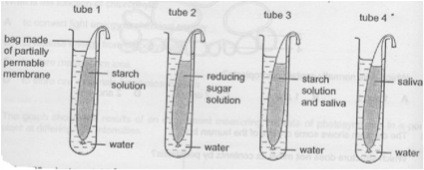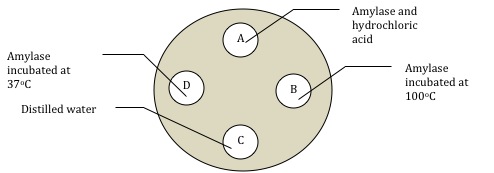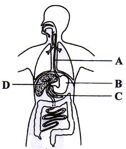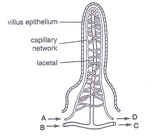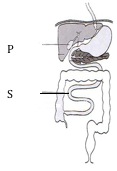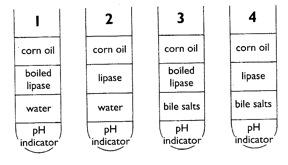A Quiz About Digestion: Trivia Questions!

What do you know about digestion? Did you know that digestion is a complex process of the body? This quiz entails learning how to determine the result of a partially permeable membrane in a tube boiled with Benedict’s solution, the appropriate diet for someone who has their gallbladder taken out of them, and the alimentary canal. This quiz presents word problems and multiple-choice questions which require you to know about digestion.
- 1.
Which of the following is an energy-rich carbohydrate stored in large quantities in the liver?
- A.
Glucose
- B.
Starch
- C.
Glycogen
- D.
Albumin
Correct Answer
C. GlycogenExplanation
Glycogen is an energy-rich carbohydrate stored in large quantities in the liver. It is a polysaccharide made up of glucose molecules and serves as a storage form of glucose. When the body needs energy, glycogen is broken down into glucose to be used as fuel. This process is especially important during periods of fasting or intense physical activity when blood glucose levels may be low. Glucose, starch, and albumin are not stored in large quantities in the liver and do not serve as a primary energy source.Rate this question:
-
- 2.
Respiration in living organisms always involves
- A.
Water production
- B.
Energy release
- C.
Breathing in of oxygen
- D.
Breathing out of carbon dioxide
Correct Answer
B. Energy releaseExplanation
Respiration in living organisms always involves energy release because it is the process by which cells convert glucose and oxygen into carbon dioxide, water, and energy in the form of ATP. This energy is essential for various cellular activities, including muscle contraction, active transport, and synthesis of molecules. Therefore, energy release is a fundamental aspect of respiration in living organisms.Rate this question:
-
- 3.
A food test is conducted to investigate the most suitable type of food to recommend to a diabetic patient who is on diet control. Which of the food below should be recommended to the patient after conducting the reducing sugar test? Food Reducing Sugar Test A Green precipitate B Brick red precipitate C Orange precipitate D Yellow precipitate
- A.
Food A
- B.
Food B
- C.
Food C
- D.
Food D
Correct Answer
A. Food AExplanation
The reducing sugar test involves the use of Benedict's solution, which changes color in the presence of reducing sugars. A green precipitate indicates a positive result for reducing sugars. Therefore, Food A should be recommended to the patient as it showed a positive result for reducing sugars in the test. Food B, C, and D did not show a positive result for reducing sugars.Rate this question:
-
- 4.
Four bags made of the partially permeable membrane are placed in tubes as shown in the diagram. After 20 minutes at 35oC, a sample of water from each tube, outside the bag, is boiled with Benedict’s solution. What are the results?
- A.
Tube 1: Blue; Tube 2: Orange Precipitate; Tube 3: Blue; Tube 4: Orange Precipitate
- B.
Tube 1: Blue; Tube 2: Orange Precipitate; Tube 3: Orange Precipitate; Tube 4: Blue
- C.
Tube 1: Orange Precipitate; Tube 2: Blue; Tube 3: Orange Precipitate; Tube 4: Blue
- D.
Tube 1: Orange Precipitate; Tube 2: Orange Precipitate; Tube 3: Blue; Tube 4: Orange Precipitate
Correct Answer
B. Tube 1: Blue; Tube 2: Orange Precipitate; Tube 3: Orange Precipitate; Tube 4: BlueExplanation
The partially permeable membrane allows only certain molecules to pass through. In this case, the blue color indicates the presence of glucose, which is small enough to pass through the membrane. The orange precipitate indicates the presence of starch, which is too large to pass through the membrane. Therefore, in Tube 1 and Tube 4, where the bag contains glucose and the water outside the bag contains starch, the water will turn blue due to the presence of glucose. In Tube 2 and Tube 3, where the bag contains starch and the water outside the bag contains glucose, the water will form an orange precipitate due to the presence of starch.Rate this question:
-
- 5.
Four different foods were tested as shown below and the test results were recorded as positive (+) or negative (-). Which food contained both glucose and oil? Food Benedict’s Test Biuret Test Ethanol Emulsion Test Iodine Test A + + - - B + - + - C - + - + D - - + +
- A.
Food A
- B.
Food B
- C.
Food C
- D.
Food D
Correct Answer
B. Food BExplanation
Food B is the correct answer because it tested positive for glucose in the Benedict's Test and positive for oil in the Ethanol Emulsion Test.Rate this question:
-
- 6.
The gall bladder stores bile. A patient in the hospital has had his gall bladder removed and needs a special diet. Which menu would be most suitable for this patient? Menu A Menu B Menu C Menu D Beans and rice Fresh orange Fried chicken and chips Sweet rice Cheese and nuts Milk Fish fried in oil and ice cream
- A.
Menu A
- B.
Menu B
- C.
Menu C
- D.
Menu D
Correct Answer
A. Menu AExplanation
Since the patient has had their gall bladder removed, they will no longer have a storage place for bile. Bile is needed for the digestion of fats. Therefore, the most suitable menu for this patient would be Menu A, which includes beans and rice and a fresh orange. This menu is low in fat and should not put strain on the patient's digestion. The other menus include fried chicken and chips, sweet rice, cheese and nuts, and fish fried in oil and ice cream, all of which are high in fat and may be difficult for the patient to digest without a gall bladder.Rate this question:
-
- 7.
A dish is filled with agar jelly containing starch. Four holes are cut in the jelly and each hole is filled with the substances shown. An iodine test is conducted on the agar after 30 minutes. Which hole will be surrounded by the largest brown region in the iodine test after 30 minutes?
- A.
Hole A
- B.
Hole B
- C.
Hole C
- D.
Hole D
Correct Answer
D. Hole DExplanation
The largest brown region in the iodine test after 30 minutes will be surrounding Hole D. This is because iodine reacts with starch to form a dark brown color. Since Hole D contains a substance that is likely to contain a high concentration of starch, it will result in a larger brown region compared to the other holes.Rate this question:
-
- 8.
Which secretion, released into the alimentary canal, contains no enzymes but speeds up fat digestion?
- A.
Bile
- B.
Intestinal Juice
- C.
Mucus
- D.
Pancreatic Juice
Correct Answer
A. BileExplanation
Bile is the correct answer because it is a secretion released into the alimentary canal that does not contain enzymes but helps in the digestion of fats. Bile is produced by the liver and stored in the gallbladder. It emulsifies fats, breaking them down into smaller droplets, which increases the surface area for the action of enzymes and facilitates their digestion by lipases. Therefore, bile speeds up fat digestion without directly participating in the chemical breakdown of fats.Rate this question:
-
- 9.
The diagram below shows the human alimentary canal. Where does the digestion of protein begin?
- A.
Organ A
- B.
Organ B
- C.
Organ C
- D.
Organ D
Correct Answer
B. Organ BExplanation
The digestion of protein begins in Organ B.Rate this question:
-
- 10.
The diagram shows the structure of villus in the small intestine. The arrows show the direction of flow of fluids. After a meal of fried chicken, where will minute fat globules be present in the largest amount?
- A.
Part A
- B.
Part B
- C.
Part C
- D.
Part D
Correct Answer
C. Part CExplanation
After a meal of fried chicken, minute fat globules will be present in the largest amount in Part C of the villus structure. This is because Part C is the lacteal, which is responsible for absorbing dietary fats. The lacteal is located in the center of the villus and is surrounded by blood capillaries. As the fat globules pass through the small intestine, they are absorbed by the lacteal and transported to the lymphatic system for further processing. Therefore, Part C is where the largest amount of fat globules will be present.Rate this question:
-
- 11.
Lipase solution was added to milk. After 30 minutes, the milk had become more acidic. What were the substrate and product in this reaction? Substrate A Amino acids Fats C Amino acids Proteins
- A.
Choice A
- B.
Choice B
- C.
Choice C
- D.
Choice D
Correct Answer
B. Choice BExplanation
The substrate in this reaction is fats and the product is amino acids. Lipase is an enzyme that breaks down fats into smaller molecules, such as amino acids. Therefore, when lipase solution is added to milk, it breaks down the fats in the milk into amino acids, resulting in the milk becoming more acidic.Rate this question:
-
- 12.
The table below represents the composition of three foods. Food (100g) X Y Z Fat/g 3.8 1.8 82.5 Protein/g 3.3 9.2 0.5 Carbohydrate/g 4.8 49.0 0.0 Calcium/g 120.0 92.0 15.0 Iron/g 0.1 1.8 0.2 Identify X, Y and Z respectively.
- A.
Bread, milk and fish respectively.
- B.
Butter, bread and milk respectively.
- C.
Milk, bread and butter respectively.
- D.
Milk, butter and bread respectively.
Correct Answer
C. Milk, bread and butter respectively.Explanation
The correct answer is Milk, bread and butter respectively. This can be determined by comparing the composition of the foods in the table. X has the highest fat content (3.8g) and the lowest protein and carbohydrate content, which matches with butter. Y has the highest protein content (9.2g) and a relatively high carbohydrate content, which matches with bread. Z has the highest fat content (82.5g) and the lowest protein and carbohydrate content, which matches with butter. Therefore, X is butter, Y is bread, and Z is milk.Rate this question:
-
- 13.
Refer to the diagram below, which shows part of the human digestive system.If structure P is removed, which of the following correctly describes the consequences?
- A.
Fatty food cannot be digested.
- B.
Oil cannot be emulsified.
- C.
Release of bile cannot be regulated.
- D.
The person will be frightened more easily.
Correct Answer
B. Oil cannot be emulsified.Explanation
If structure P is removed from the human digestive system, the consequence would be that oil cannot be emulsified. Emulsification of oil is an important process that occurs in the digestive system, specifically in the small intestine, where bile salts produced by the liver help break down fat globules into smaller droplets. This emulsification process increases the surface area of the fat, allowing enzymes called lipases to efficiently break it down into smaller molecules that can be absorbed by the body. Without structure P, the emulsification of oil would be compromised, leading to difficulties in digesting and absorbing fats.Rate this question:
-
- 14.
What is the likely effect of removing part of the small intestine?
- A.
The person dies of starvation.
- B.
The person suffers from constipation.
- C.
The person loses appetite.
- D.
The person loses weight.
Correct Answer
D. The person loses weight.Explanation
Removing part of the small intestine can lead to malabsorption of nutrients, as the small intestine is responsible for absorbing nutrients from food. This can result in weight loss, as the body is not able to effectively extract and utilize the necessary nutrients for maintaining a healthy weight.Rate this question:
-
- 15.
Four test tubes are set up as shown below to investigate the effect of bile salts and the effect of boiling on the activity of lipase. An emulsion test will be conducted for this investigation. Thus, comparing the results from which tubes could draw conclusions about the effect of boiling on the activity of lipase?
- A.
1 and 3
- B.
1 and 4
- C.
2 and 3
- D.
3 and 4
Correct Answer
D. 3 and 4Explanation
Comparing the results from tubes 3 and 4 can draw conclusions about the effect of boiling on the activity of lipase. This is because tube 3 contains bile salts and is not boiled, while tube 4 contains bile salts and is boiled. By comparing the results of these two tubes, we can determine whether boiling has an effect on the activity of lipase in the presence of bile salts.Rate this question:
-
Quiz Review Timeline +
Our quizzes are rigorously reviewed, monitored and continuously updated by our expert board to maintain accuracy, relevance, and timeliness.
-
Current Version
-
Mar 22, 2023Quiz Edited by
ProProfs Editorial Team -
Feb 16, 2010Quiz Created by
Sstscience
 Back to top
Back to top



